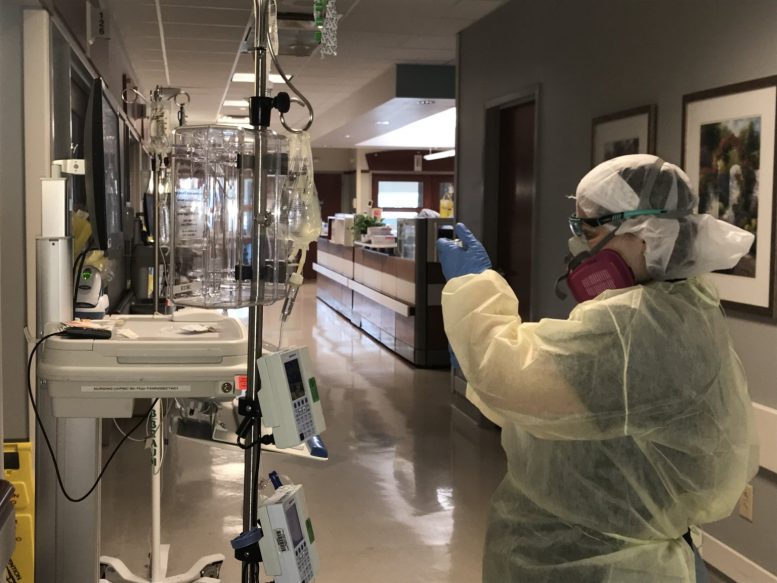In Clark County, more COVID-19 infections are coming in than the health department can contact trace.
Health Commissioner Charles Patterson said in a news release they’re simply “overwhelmed” with cases, and those in the backlog will receive a packet of information about their diagnosis and educational materials.
Kyle Trout, a department public information officer, said they’re receiving about 80 new cases per day, compared to the 50 they can handle. The logjam spans about 300 cases.
“All across the state, we’re seeing record numbers,” he said. “I don’t think people understand health departments are working seven days a week, sometimes 12-hour days. We’re just kind of drowning.”
On Tuesday, Ohio smashed its one-day records for new cases (6,508), new hospitalizations (386), total number of people currently hospitalized (2,747), and positivity rate (11% on Monday).
https://datawrapper.dwcdn.net/j4uzg/1/
More than 300 Ohioans with COVID-19 are breathing with the assistance of a mechanical ventilator, the most at any point during the pandemic.
All told, 5,547 Ohioans have died from COVID-19; more than 21,000 have been hospitalized; more than 261,000 have been infected.
The new case downpour extends statewide.
Preble County Public Health issued a news release warning that the caseload has outgrown the department’s tracing abilities. The department is advising residents to act as their own contact tracers and notify their places of employment, worship, school, gym, etc.
“We’re still pretty swamped,” said Preble Health Commissioner Erik Balster in an interview Tuesday. “It’s only gotten worse as the weeks have gone on, as far as our backlog.”
In Knox County, Health Commissioner Julie Miller issued public health orders that “limit gatherings of any size;” recommend that anyone who can work from home do so; and compel businesses to enforce mask wearing from employees and customers.
The department also ordered a preschool to close due to staff and student infections.
“Nine months into the pandemic, we have let our guard down,” she said in a news release. “People are not wearing masks. They are not social distancing. As a community, we need to take of one another. It’s time to step up and mask up.”
On Monday, hospital executives and the Ohio Department of Health’s chief medical officer hosted a news conference warning of a growing staffing strain as more and more caregivers are infected with COVID-19. If the trendlines don’t change, they warned, Ohio’s hospitals will have to restrict non-essential services.
Ohio’s increases are mild compared to those seen in the Mountain West or other Midwest states like Iowa, Wisconsin and Illinois, according to state-by-state infection rate data from The New York Times.
“We’re in the most dangerous part of our pandemic response,” said Dr. Howard Koh, an epidemiologist from the Harvard T.H. Chan School of Public Health, speaking to reporters Tuesday.
Ohio’s Public Health Advisory System, a risk indicator based on inputs like new case rates or medical visits in a county, placed 56 counties comprising 86% of the state population on red status last week, indicating “very high exposure and spread.”
In an unusual move, Gov. Mike DeWine canceled his twice-weekly COVID-19 press conference Tuesday. Instead, he announced plans to deliver a statewide broadcast at 5:30 p.m. Wednesday evening “to discuss the critical state Ohio is at in battling COVID-19.”
The announcement echoes DeWine’s fireside chat in July, the last time cases surged in Ohio. On July 15, he spoke with a more conversational tone from the governor’s office in an evening broadcast as opposed to the usual early afternoon affair.
He warned that “we have now reached the most critical point in our battle against the coronavirus” and called for “immediate action” as cases surged across the Sun Belt.
DeWine didn’t announce any mask mandate during the speech, despite calls for him to do so and cities stepping out on their own to require facial coverings. Instead, he pleaded with Ohioans to mask up and stay home.
“If we do not change course, Florida and Arizona will be our future,” DeWine said.
The Ohio Department of Health issued a mask mandate exactly one week later.
***
Also from Ohio Capital Journal:
FirstEnergy firings prompt regulatory audit in nuclear bailout scandal
It slipped under the radar last week, but on the day after the presidential election the Public Utility Commission of Ohio ordered a management audit of Akron-based FirstEnergy Corp. to determine whether it abided by separation rules when it spun off its nuclear reactors in 2016.
The regulators made the move after FirstEnergy on Oct. 29 fired CEO Chuck Jonesin the wake of a $61 million nuclear bailout scandal.
Former House Speaker Larry Householder and four associates were arrested in July in what federal law enforcement called the largest bribery scandal in Ohio history. They’re accused of funneling money from FirstEnergy and associated companies through 501(c)(4) “dark money” groups and into House campaigns aimed at making Householder speaker and passing House Bill 6 — a $1.3 billion bailout of two Northern Ohio nuclear reactors owned by FirstEnergy until late 2016.
The audit ordered last week appears to be aimed at determining whether FirstEnergy violated Ohio laws governing the company’s 2016 separation from its nuclear-owning subsidiary, FirstEnergy Solutions.
FirstEnergy had staunchly defended Jones in the wake of Householder’s arrest, claiming that corporate leadership “has not had any decision-making power regarding the strategic direction” of the successor company that owned the nuclear plants. FirstEnergy Solutions went through bankruptcy and after it emerged earlier this year it was renamed Energy Harbor. READ MORE
HELP OHIO CAPITAL JOURNAL GROW Make a tax deductible contribution





